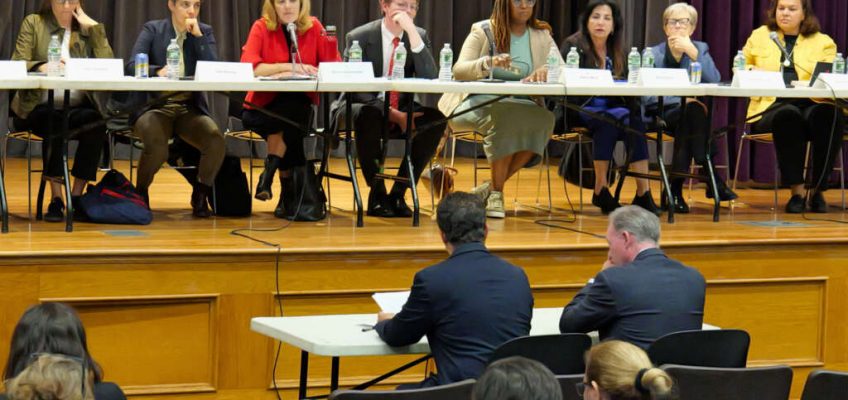“To address the problem of member deference, land use approvals could be taken from the Council’s jurisdiction. I suggest the creation of a new city position, the Zoning Administrator, who would be entrusted with approvals expected to result in few real-world adverse effects.”
Members of the 2025 charter revision commission at a public hearing in Brooklyn last month. (X/NYC Charter Revision Commission)
In the spring of 2025, a New York City Charter Revision Commission is considering, largely in media obscurity, big changes in the distribution of power and patronage in the city. In a new Manhattan Institute brief, I discuss one category of potential major changes to the city charter, affecting the land use decision-making process.
The city regulates land use in several ways, principally through enacting zoning but also by mapping streets and parks, constructing infrastructure, and acquiring and disposing of land for public projects. Under Mayor Fiorello LaGuardia in the 1930s, the City Planning Commission and the Department of City Planning were established to ensure these decisions were made in a professional manner, taking citywide needs into account.
But the city charter drafters of the era also specified that a political body, the Board of Estimate, would make the final decision. However, the structure of the board, which included three citywide officials (the mayor, comptroller and City Council president) and the five borough presidents, ensured that the mayor usually had his way.
Back then, the process for making land use decisions was fast—it could be over in a couple of months—and much abused by mayors, often conniving with the infamous master builder, Robert Moses. Highways were blasted through residential neighborhoods and urban renewal projects displaced thousands of households.
The backlash against such practices started in the 1960s. Community boards were created as a neighborhood voice, and environmental review requirements were instituted. That slowed the process down greatly, allowing opponents time to organize. The mayor still had a lot of influence, but opponents had more opportunities to make an impact.
The culmination of these process changes came in 1989, when another charter revision commission abolished the Board of Estimate in the wake of a corruption scandal and an adverse U.S. Supreme Court decision. The final decision-maker on land use was now the City Council, and the mayor had much less leverage. The Council would, and did, flatly turn down land use applications, something that rarely happened in the Board of Estimate era.
There is a view, not universally held but widespread among civic groups and observers of the land use process, that these changes have induced political paralysis. After 1989, New York City prospered, with skyrocketing population and employment. However, the participants in the land use process have failed to address the city’s obvious interest in providing an adequate housing stock to meet the needs of that population and allow for continued economic growth.
Some argue that this is not a consequence of the defects in New York City’s governmental structure, but that politicians, planners and other stakeholders have not bargained well enough. After decades of crisis, however, that argument wears thin to critics.
Those critics identify two major issues. First, the process is too long. Getting through often takes years, at great expense, and the elected officials who support a proposal at its inception may not even be in office when the City Council votes. Second, the City Council has evolved a practice of “member deference,” in which the rest of the Council defers to the views of the member in whose district a proposed development is located. That gives local opponents undue power and ensures that citywide needs are never addressed.
What city charter changes would help? The length of the land use process is largely due to environmental review. Unfortunately, that is specified in state law, which means the charter revision commission cannot change it, but the state legislature could. Good legislation has fortunately been introduced in Albany, and the governor and legislature should work to get it enacted.
The charter revision commission does have the ability to shorten the formal land use review process, known as ULURP, from seven to six months by having the borough presidents, borough boards and community boards review applications in a concurrent 60-day period. Since time is money for applicants, that would lead to savings. Another useful change would be to take non-controversial changes out of ULURP, wasting less of everybody’s time.
To address the problem of member deference, land use approvals could be taken from the Council’s jurisdiction. I suggest the creation of a new city position, the Zoning Administrator, who would be entrusted with approvals expected to result in few real-world adverse effects.
Among those approvals would be construction of small multifamily apartment buildings in low-rise neighborhoods. Such buildings exist throughout the city as a remnant of once more-generous zoning, and provide “naturally occurring” affordable housing, not needing public subsidy. New ones, however, are among the hardest changes to get past councilmembers and their angry homeowner constituents. Citywide voters in a charter referendum, however, might be willing to countenance what individual councilmembers would not do.
These and other suggestions from civic groups, if adopted, might create a better process than the 1989 framework provides.
That won’t solve the housing crisis—there is still much more work to do. It will, however, lower costs and supply better incentives to do the right thing. That would make the charter revision commission’s labors well worthwhile.
Eric Kober is a senior fellow at the Manhattan Institute and former Department of City Planning official.
The post Opinion: NYC Panel Asks, Who Controls Land Use? appeared first on City Limits.


Leave a Reply